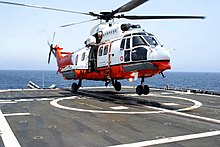|
Government Flying Service
The Hong Kong Government Flying Service (HKGFS) is a disciplined unit and paramilitary flying organisation of the Government of Hong Kong. The service has its head office in, and operates from, the southwestern end of Hong Kong International Airport at Chek Lap Kok.[2] Before the opening of the Chek Lap Kok airport in 1998, it operated from the old Kai Tak Airport, the former Hong Kong International Airport. GFS patrols as far as 700-nautical-mile (1,300 km) to the south, to include the Hong Kong Flight Information Region and the Hong Kong Maritime Rescue Coordination Centre area of responsibility, which covers most of the South China Sea basin. HistoryThe Government Flying Service was established on 1 April 1993, when Hong Kong was under British rule.[3] It then took over all the non-military operations of the Royal Hong Kong Auxiliary Air Force (RHKAAF), which was an auxiliary unit of the United Kingdom Royal Air Force. After Hong Kong was handed over to the People's Republic of China in 1997, the GFS remained as a government unit of the Hong Kong Special Administrative Region, and is responsible for search and rescue (SAR), air ambulance, firefighting, and police operations.[4] Starting in 2012, the GFS operates from the HKCEC heliport, adjacent to Golden Bauhinia Square.[5] The site is also open to commercial traffic.[6] In August 2020, a GFS Bombardier Challenger 605 maritime patrol aircraft was believed to have assisted Chinese authorities in intercepting 12 Hong Kongers who were attempting to flee to Taiwan due to increasingly onerous conditions in Hong Kong and enhanced exit controls. The Hong Kong government denied that they had cooperated with Chinese authorities.[7] On December 21, 2020, the United States Bureau of Industry and Security amended the Export Administration Regulations by adding a new ‘Military End User' (MEU) List, as well as the first tranche of 103 entities, which includes 58 Chinese and 45 Russian companies. Government Flying Service was added as one of 103 entities to the MEU List.[8] In 2022, a new site at the southernmost corner of the former Kai Tak airport was opened, featuring one landing/takeoff pad, two parking pads, one repair hangar for the new Airbus H175 helicopter and an operations/office building.[9] The site had been earmarked since 2007 and planning permission was given in 2017 as part of the area's redevelopment,[10][11] as well as limitations of new high rise buildings in the Tung Chung area near the existing base affecting marginal weather operations. The possibility of opening the base to commercial cross-boundary traffic has been raised since 2011.[12] OperationsGFS consists of five divisions:
Helicopters can land on five highways in Hong Kong to attend to road related recovery operations. For long-range search and rescue operations, the GFS initially use fixed wing aircraft which then guide helicopters to the location.[3]
The GFS operates primarily from Chek Lap Kok airport, where headquarters and all fixed wing aviation is based. Some helicopters are based in the Kai Tak division and a helipad is available in Wan Chai next to the HKCEC. Current inventory
Equipment and gear Standard equipment for GFS personnel is:
PersonnelGFS employs 335 personnel:[14]
Most of the pilots in the GFS were localised prior to the handover in 1997, as former RAF and other British military personnel departed Hong Kong. The GFS is led by a Controller, who reports to the Secretary for Security. The current Controller is Captain West WH WU. Other senior officers of the GFS are:
UniformOperations uniforms:
Dress uniforms:[19]
RankPrior to the creation of the GFS, the ranks within the Royal Hong Kong Auxiliary Air Force were the same as the RAF. The late 1980s and early 1990s saw the transition to local staff in the RHKAAF in preparation for the civil transfer to the GFS role. Ranking of personnel of the GFS are civilian aviation roles and are as follows: Pilot II and Cadet Pilot ranks were created in the 1990s for local pilots with less flying experience. ControllersList of past controllers of the GFS:
CrestThe current crest of the force was adopted in 1997, prior to which the Hong Kong Coat of Arms was used on GFS aircraft. The current is topped with the Hong Kong Bauhinia flower. In the centre of the crest is a navy blue (sometimes purple) and light blue roundel background. In the middle of the crest is a four bladed propeller, and a Chinese dragon in the front (similar to the RHKAAF crest). Along the bottom of the roundel are the letters GFS representing the english name of the service. Underneath the roundel are a pair of wings joined by a ribbon with the Chinese characters "政府飛行服務隊", the Chinese name of the service. GFS in the media
Incidents
See alsoReferences
External linksWikimedia Commons has media related to Hong Kong Government Flying Service. |
||||||||||||||||||||||||||||||||||||||||||||||||||||||||||||||||||||||||||||||||||||||||||||||||||||||||||||










